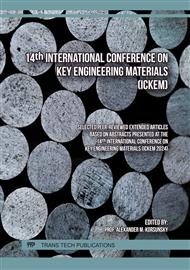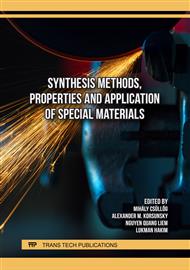[1]
L. Xiao and W. Song, "Additively-manufactured functionally graded Ti-6Al-4V lattice structures with high strength under static and dynamic loading: Experiments," Int. J. Impact Eng., vol. 111, p.255–272, 2018.
DOI: 10.1016/j.ijimpeng.2017.09.018
Google Scholar
[2]
X. Wu, R. Liu, J. Zhao, and Z. Fan, "Advanced carbon materials with different spatial dimensions for supercapacitors," Nano Mater. Sci., vol. 3, no. 3, p.241–267, 2021.
DOI: 10.1016/j.nanoms.2021.01.002
Google Scholar
[3]
F. Usta, H. S. Türkmen, and F. Scarpa, "Low-velocity impact resistance of composite sandwich panels with various types of auxetic and non-auxetic core structures," Thin-Walled Struct., vol. 163, no. November 2020, p.107738, 2021.
DOI: 10.1016/j.tws.2021.107738
Google Scholar
[4]
S. Lecturer, "Front Matter," Anal. Des. Struct. Sandw. Panels, p. iii, 1969.
DOI: 10.1016/b978-0-08-012870-2.50001-8
Google Scholar
[5]
G. Turnbull et al., "3D biofabrication for soft tissue and cartilage engineering," Med. Eng. Phys., vol. 82, p.13–39, 2020.
DOI: 10.1016/j.medengphy.2020.06.003
Google Scholar
[6]
Y. Sun and L. Gao, "Structural responses of all-composite improved-pyramidal truss sandwich cores," Mater. Des., vol. 43, p.50–58, 2013.
DOI: 10.1016/j.matdes.2012.06.033
Google Scholar
[7]
H. Pang et al., "Research advances in composition, structure and mechanisms of microwave absorbing materials," Compos. Part B Eng., vol. 224, no. July, p.109173, 2021.
DOI: 10.1016/j.compositesb.2021.109173
Google Scholar
[8]
M. T. uddeen Safian, K. Umar, and M. N. Mohamad Ibrahim, "Synthesis and scalability of graphene and its derivatives: A journey towards sustainable and commercial material," J. Clean. Prod., vol. 318, no. July, p.128603, 2021.
DOI: 10.1016/j.jclepro.2021.128603
Google Scholar
[9]
A. S. Perna, A. Viscusi, R. Della Gatta, and A. Astarita, "Integrating 3D printing of polymer matrix composites and metal additive layer manufacturing: surface metallization of 3D printed composite panels through cold spray deposition of aluminium particles," Int. J. Mater. Form., vol. 15, no. 2, 2022.
DOI: 10.1007/s12289-022-01665-9
Google Scholar
[10]
D. Krapež Tomec and M. Kariž, "Use of Wood in Additive Manufacturing: Review and Future Prospects," Polymers (Basel)., vol. 14, no. 6, 2022.
DOI: 10.3390/polym14061174
Google Scholar
[11]
A. N. Dickson, H. M. Abourayana, and D. P. Dowling, "3D printing of fibre-reinforced thermoplastic composites using fused filament fabrication-A review," Polymers (Basel)., vol. 12, no. 10, 2020.
DOI: 10.3390/POLYM12102188
Google Scholar
[12]
M. Nazarian-Samani, S. Haghighat-Shishavan, M. Nazarian-Samani, S. F. Kashani-Bozorg, S. Ramakrishna, and K. B. Kim, "Perforated two-dimensional nanoarchitectures for next-generation batteries: Recent advances and extensible perspectives," Prog. Mater. Sci., vol. 116, no. June, p.100716, 2021.
DOI: 10.1016/j.pmatsci.2020.100716
Google Scholar
[13]
R. Kumar, E. Joanni, R. K. Singh, D. P. Singh, and S. A. Moshkalev, "Recent advances in the synthesis and modification of carbon-based 2D materials for application in energy conversion and storage," Prog. Energy Combust. Sci., vol. 67, p.115–157, 2018.
DOI: 10.1016/j.pecs.2018.03.001
Google Scholar
[14]
M. N. Tamin, Damage and fracture of composite materials and structures, vol. 17. 2012.
Google Scholar
[15]
D. Bonthu, H. S. Bharath, S. Gururaja, P. Prabhakar, and M. Doddamani, "3D printing of syntactic foam cored sandwich composite," Compos. Part C Open Access, vol. 3, no. October, p.100068, 2020.
DOI: 10.1016/j.jcomc.2020.100068
Google Scholar
[16]
ElHassan, A.; Ahmed, W.; Zaneldin, E. A Comparative Investigation of the Reliability of Biodegradable Components Produced through Additive Manufacturing Technology. Polymers 2024, 16, 615.
DOI: 10.3390/polym16050615
Google Scholar
[17]
Ahmed, W.; Zaneldin, E.; El Hassan, A. Investigating the Integrity and Failure Characteristics of Deteriorated Polymeric 3D-Printed Components as Candidates for Structural and Construction Applications. Buildings 2023, 13, 2402
DOI: 10.3390/buildings13102402
Google Scholar
[18]
Al Rashid, W. Ahmed, M. Y. Khalid, and M. Koç, "Vat photopolymerization of polymers and polymer composites: Processes and applications," Addit. Manuf., vol. 47, p.102279, 2021.
DOI: 10.1016/j.addma.2021.102279
Google Scholar
[19]
Ahmed, W. K., & Teng, H. (2014). Characterisation of fractured particulate reinforced composite. International Journal of Microstructure and Materials Properties, 9(2), 160.
DOI: 10.1504/ijmmp.2014.066563
Google Scholar
[20]
Zaneldin, E.; Ahmed, W.; Mansour, A.; Hassan, A.E. Dimensional Stability of 3D Printed Objects Made from Plastic Waste Using FDM: Potential Construction Applications. Buildings 2021, 11, 516.
DOI: 10.3390/buildings11110516
Google Scholar
[21]
Ahmed, W.; Zanledin, E.; Kabbani, S. Fracture Mechanics Performance of Through-Thickness Crack of Polymeric 3D Printed Components. Lect. Notes Mech. Eng. 2020, 12, 302
Google Scholar



